brake light Lancia Thesis 2007 Owner handbook (in English)
[x] Cancel search | Manufacturer: LANCIA, Model Year: 2007, Model line: Thesis, Model: Lancia Thesis 2007Pages: 386, PDF Size: 8.69 MB
Page 213 of 386
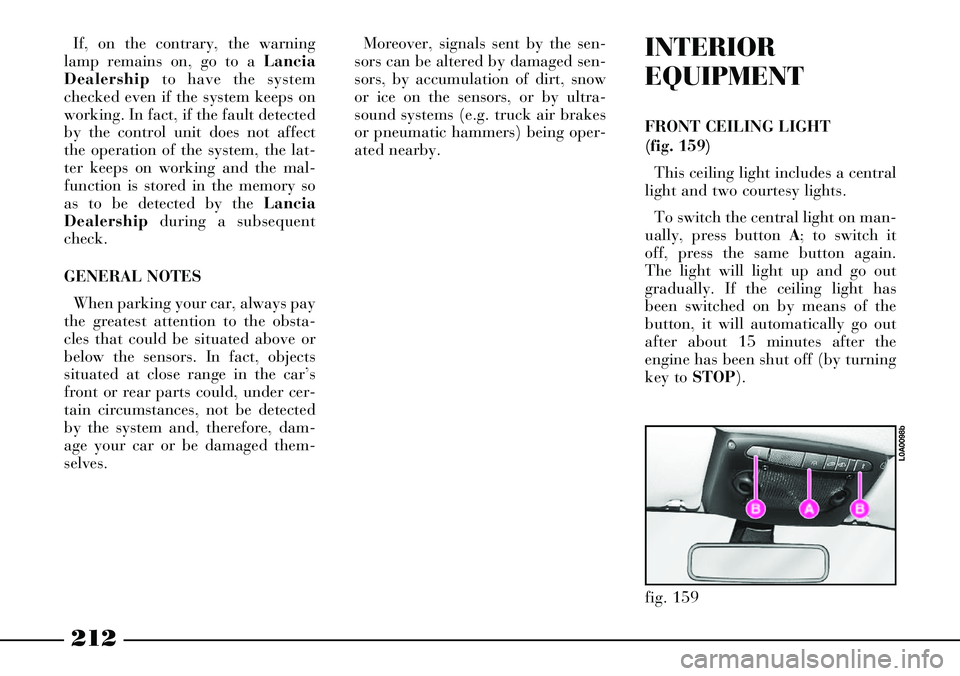
212
If, on the contrary, the warning
lamp remains on, go to a Lancia
Dealership to have the system
checked even if the system keeps on
working. In fact, if the fault detected
by the control unit does not affect
the operation of the system, the lat-
ter keeps on working and the mal-
function is stored in the memory so
as to be detected by the Lancia
Dealership during a subsequent
check.
GENERAL NOTES
When parking your car, always pay
the greatest attention to the obsta-
cles that could be situated above or
below the sensors. In fact, objects
situated at close range in the car’s
front or rear parts could, under cer-
tain circumstances, not be detected
by the system and, therefore, dam-
age your car or be damaged them-
selves.Moreover, signals sent by the sen-
sors can be altered by damaged sen-
sors, by accumulation of dirt, snow
or ice on the sensors, or by ultra-
sound systems (e.g. truck air brakes
or pneumatic hammers) being oper-
ated nearby.INTERIOR
EQUIPMENT
FRONT CEILING LIGHT
(fig. 159)
This ceiling light includes a central
light and two courtesy lights.
To switch the central light on man-
ually, press button A; to switch it
off, press the same button again.
The light will light up and go out
gradually. If the ceiling light has
been switched on by means of the
button, it will automatically go out
after about 15 minutes after the
engine has been shut off (by turning
key to STOP).
fig. 159
L0A0098b
Page 234 of 386

233
These rings can also be used to fas-
ten the luggage net (optional, can be
purchased at a Lancia Dealership).LUGGAGE TRANSPORT -
IMPORTANT
The car is equipped with a system
that automatically keeps headlight
height steady on different loading
conditions. The adjusting system
works properly with the maximum
allowed loads: always make sure
that the load you are carrying does
not exceed the values specified in
chapter “Technical Specifications”.
When using the boot,
make sure the load you
are carrying does not
exceed the maximum allowed
weight (see the “Technical
Specifications” chapter). Also
ensure the items in the boot are
arranged properly and fastened
with straps to the specific hooks
to prevent them being thrown for-
wards and injuring passengers
should you brake sharply.Heavy loads which are
not securely anchored
could seriously injure
passengers in the event of an
accident.
If you need to carry
petrol in a jerry-can,
always comply with the
law regulations and use a certi-
fied can, which must be properly
secured to the fastening rings. In
any case, the risk of fire in case of
accident is high.
fig. 202
L0A0220b
Page 247 of 386
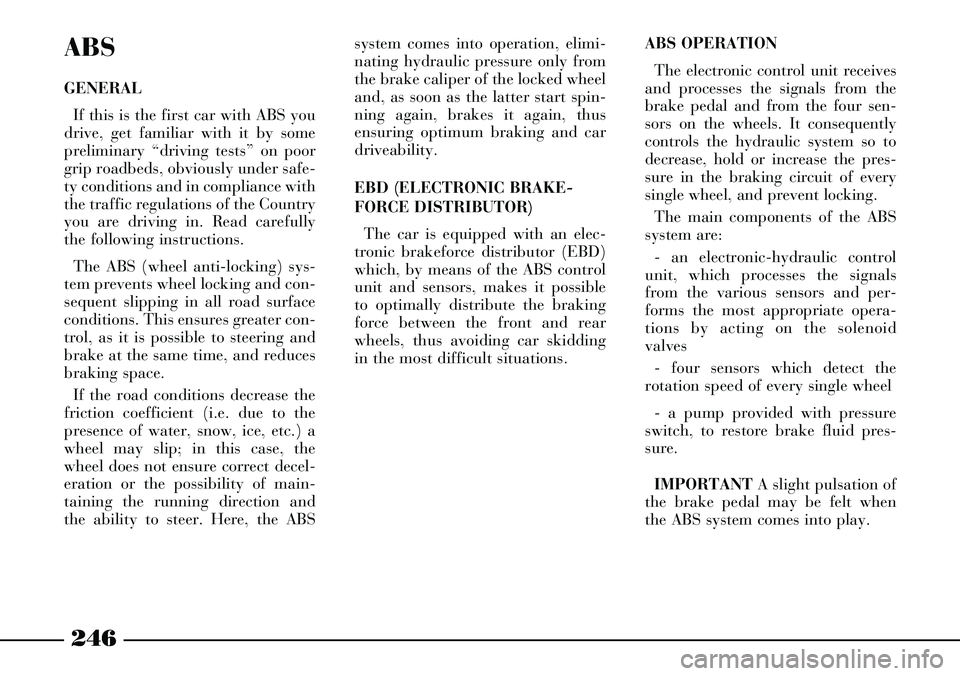
246
ABS
GENERAL
If this is the first car with ABS you
drive, get familiar with it by some
preliminary “driving tests” on poor
grip roadbeds, obviously under safe-
ty conditions and in compliance with
the traffic regulations of the Country
you are driving in. Read carefully
the following instructions.
The ABS (wheel anti-locking) sys-
tem prevents wheel locking and con-
sequent slipping in all road surface
conditions. This ensures greater con-
trol, as it is possible to steering and
brake at the same time, and reduces
braking space.
If the road conditions decrease the
friction coefficient (i.e. due to the
presence of water, snow, ice, etc.) a
wheel may slip; in this case, the
wheel does not ensure correct decel-
eration or the possibility of main-
taining the running direction and
the ability to steer. Here, the ABSsystem comes into operation, elimi-
nating hydraulic pressure only from
the brake caliper of the locked wheel
and, as soon as the latter start spin-
ning again, brakes it again, thus
ensuring optimum braking and car
driveability.
EBD (ELECTRONIC BRAKE-
FORCE DISTRIBUTOR)
The car is equipped with an elec-
tronic brakeforce distributor (EBD)
which, by means of the ABS control
unit and sensors, makes it possible
to optimally distribute the braking
force between the front and rear
wheels, thus avoiding car skidding
in the most difficult situations.ABS OPERATION
The electronic control unit receives
and processes the signals from the
brake pedal and from the four sen-
sors on the wheels. It consequently
controls the hydraulic system so to
decrease, hold or increase the pres-
sure in the braking circuit of every
single wheel, and prevent locking.
The main components of the ABS
system are:
- an electronic-hydraulic control
unit, which processes the signals
from the various sensors and per-
forms the most appropriate opera-
tions by acting on the solenoid
valves
- four sensors which detect the
rotation speed of every single wheel
- a pump provided with pressure
switch, to restore brake fluid pres-
sure.
IMPORTANTA slight pulsation of
the brake pedal may be felt when
the ABS system comes into play.
Page 248 of 386

247
The car is fitted with an
electronic brake force
distributor (EBD). The x
and >warning lights come on at
the same time on the multifunc-
tion display, together with mes-
sage “EBD SYSTEM FAULT”,
when the engine is running to
indicate that there is an EBD sys-
tem failure. In this case violent
braking may be accompanied by
early rear wheel locking with the
possibility of skidding. Drive the
car extremely carefully to the
nearest Lancia Dealership to
have the system checked.
If warning light x
comes on together with
message “LOW BRAKE
FLUID LEVEL”, on the multi-
function display, stop the car
immediately and contact a Lancia
Dealership. Fluid leakage will
compromise efficiency of both the
traditional brake system and the
ABS system.The system performance
in terms of active safety
must not lead the driver
to take unnecessary or unjusti-
fied risks. Always suit your dri-
ving style to the weather, visibili-
ty and traffic conditions.
Excessive use of engine
braking (gears tooshort
and limited grip) may
make the wheels slip. The ABS
will have no effect on this type of
skidding.
The maximum possible
deceleration always
depends on the available
road grip. Obviously, grip will be
considerably decreased in the
presence of snow and ice. In these
conditions, the braking space
will still be high, even with the
ABS.The coming on of the
>warning light on the
multifunction display,
together with message “ABS SYS-
TEM FAULT”, when the engine is
running, normally indicates a
fault in the ABS system. In this
case the braking system will still
be effective although without the
anti-lock device assistance. In
these conditions, EBD system
operation may also be reduced.
Drive the car extremely carefully
to the nearest Lancia Dealership
to have the ABS system checked.
Page 252 of 386

251
HOW TO START PETROL
VERSIONS
IMPORTANTNever press the
accelerator before the engine has
started.
1) Ensure that the electric parking
brake is on (instrument panel warn-
ing light xon).
2) Ensure that electrical systems
and devices, especially high absorp-
tion ones (e.g. heated rear window),
are off.
3) On versions with manual gear-
box, set the gear lever to neutral and
press the clutch pedal fully down to
avoid the starter dragging the gears.4) On versions with electronic
automatic gearbox, ensure that the
selector is at Pand keep the brake
pedal pressed.
5) Turn the ignition key to AVV
and release it as soon as the engine
starts.
6) If the engine fails to start, return
the key to STOPand repeat the pro-
cedure.
IMPORTANTIf the engine does
not start at the first attempt, do not
keep turning the ignition key to
avoid damaging the catalyst.
Contact a Lancia Dealership.HOW TO START JTD VERSIONS
1) Ensure that the electric parking
brake is on (instrument panel warn-
ing light xon).
2) Put the gear lever to neutral.
3) Turn the ignition key to MAR.
4) Wait until the mwarning light
is off: the hotter the engine is, the
quicker this will happen.
When the engine is particularly hot
the warning light may come on so
quickly that it is impossible to notice
it.
5)Press the clutch pedal down to
the floor.
6) Turn the ignition key to AVV
immediately after the mwarning
light goes out. If you wait too long,
you will lose the benefit of the work
done by the glow plugs.
Page 254 of 386

253
Remember that until the
engine has started, the
brake booster and power
steering systems will not work
and a greater effort will therefore
be required to press the brake
pedal and turn the steering
wheel. For cars equipped with
turbosupercharger in
particular, but generally
for any kind of cars, avoid abrupt
accelerations immediately before
turning the engine off. A quick
burst on the accelerator serves
absolutely no practical purpose,
wastes fuel and may damage seri-
ously the turbosupercharger
rotor bearings.EMERGENCY START-UP
If the Lancia CODE system fails to
recognise that code transmitted by
the ignition key (symbol Ytogeth-
er with message “VEHICLE PRO-
TECTION SYSTEM FAULT” on the
multifunction display) the emer-
gency start-up can be performed by
using the CODE card code.
For the correct procedure see chap-
ter “In an emergency”.
Before opening the lug-
gage compartment bonnet
to reload the battery or to
connect an auxiliary battery,
carefully read and comply with
the instructions contained in the
paragraph “If battery is to be dis-
connected” in the chapter “In an
emergency”. Never bump start the
engine (by pushing, tow-
ing or coasting downhill)
as this could cause fuel to flow
into the catalytic exhaust system
and damage it beyond repair.
IMPORTANTIf the engine turns
off while the car is running, the
Lancia CODE symbol Yand the
message “VEHICLE PROTECTION
SYSTEM FAULT” may appear on
the multifunction display when the
engine starts again. In this case
check that the warning light switch-
es off when turning the engine off
and on again with the car stationary.
Otherwise contact aLancia
Dealership.
Page 256 of 386
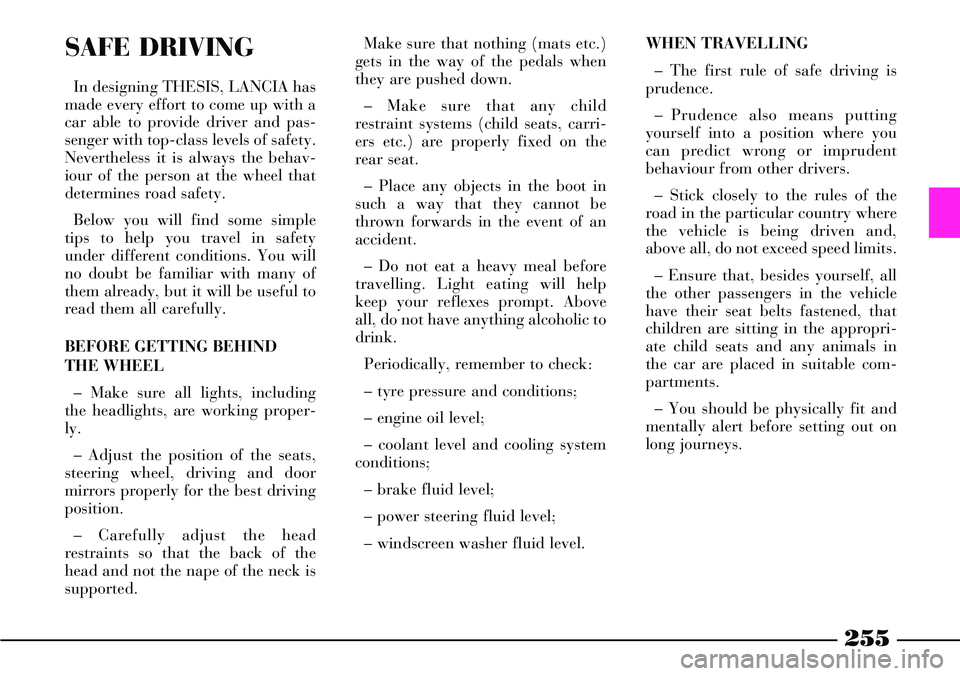
255
SAFE DRIVING
In designing THESIS, LANCIA has
made every effort to come up with a
car able to provide driver and pas-
senger with top-class levels of safety.
Nevertheless it is always the behav-
iour of the person at the wheel that
determines road safety.
Below you will find some simple
tips to help you travel in safety
under different conditions. You will
no doubt be familiar with many of
them already, but it will be useful to
read them all carefully.
BEFORE GETTING BEHIND
THE WHEEL
– Make sure all lights, including
the headlights, are working proper-
ly.
– Adjust the position of the seats,
steering wheel, driving and door
mirrors properly for the best driving
position.
– Carefully adjust the head
restraints so that the back of the
head and not the nape of the neck is
supported. Make sure that nothing (mats etc.)
gets in the way of the pedals when
they are pushed down.
– Make sure that any child
restraint systems (child seats, carri-
ers etc.) are properly fixed on the
rear seat.
– Place any objects in the boot in
such a way that they cannot be
thrown forwards in the event of an
accident.
– Do not eat a heavy meal before
travelling. Light eating will help
keep your reflexes prompt. Above
all, do not have anything alcoholic to
drink.
Periodically, remember to check:
– tyre pressure and conditions;
– engine oil level;
– coolant level and cooling system
conditions;
– brake fluid level;
– power steering fluid level;
– windscreen washer fluid level. WHEN TRAVELLING
– The first rule of safe driving is
prudence.
– Prudence also means putting
yourself into a position where you
can predict wrong or imprudent
behaviour from other drivers.
– Stick closely to the rules of the
road in the particular country where
the vehicle is being driven and,
above all, do not exceed speed limits.
– Ensure that, besides yourself, all
the other passengers in the vehicle
have their seat belts fastened, that
children are sitting in the appropri-
ate child seats and any animals in
the car are placed in suitable com-
partments.
– You should be physically fit and
mentally alert before setting out on
long journeys.
Page 257 of 386

256
Make sure that any mats
are appropriate in size:
any hindrance, even
slight, to the braking system may
require a higher pedal stroke
than normal.
Water, ice and salt on
the road may deposit on
brake disks, reducing
braking efficiency the first time
they are used.Driving while drunk or
under the influence of
drugs or certain medi-
cines is dangerous both for you
and other road users.
Always fasten both front
and back seat belts,
including child restraint
systems if there are children trav-
elling with you. Travelling with
seat belts unfastened increases
the risk of injury or death if you
are involved in a collision. Take care when fitting
additional spoilers, alloy
rims and wheel caps: they
might reduce ventilation of the
brakes, thus their efficiency dur-
ing abrupt braking or long down-
hill slopes.
Never drive with objects
on the floor in front of the
driver’s seat: they might
get stuck under the pedals mak-
ing it impossible to accelerate or
brake.
Page 258 of 386
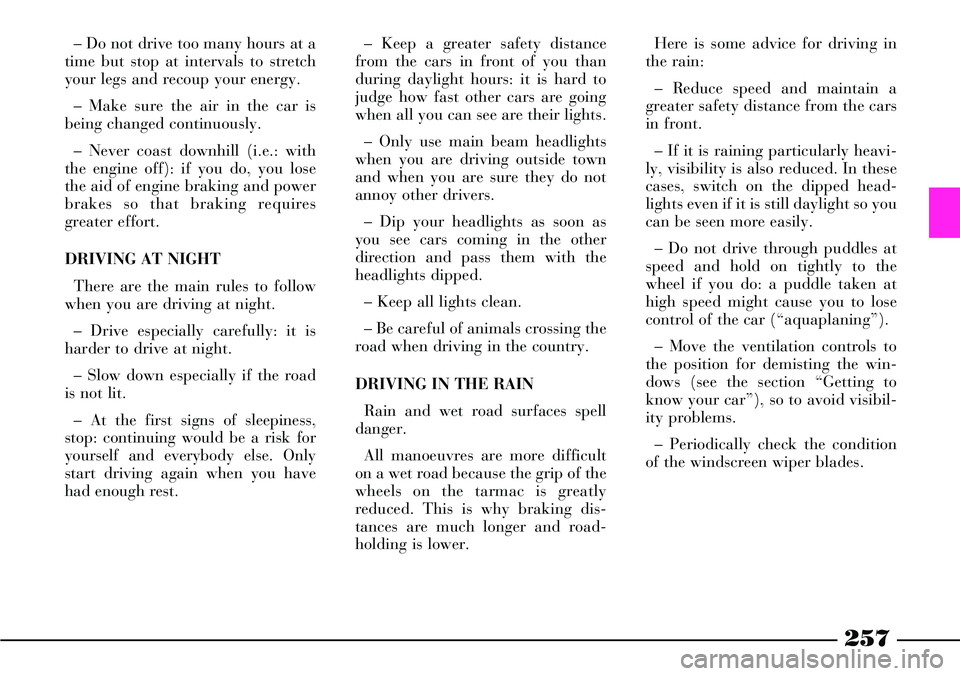
257
– Keep a greater safety distance
from the cars in front of you than
during daylight hours: it is hard to
judge how fast other cars are going
when all you can see are their lights.
– Only use main beam headlights
when you are driving outside town
and when you are sure they do not
annoy other drivers.
– Dip your headlights as soon as
you see cars coming in the other
direction and pass them with the
headlights dipped.
– Keep all lights clean.
– Be careful of animals crossing the
road when driving in the country.
DRIVING IN THE RAIN
Rain and wet road surfaces spell
danger.
All manoeuvres are more difficult
on a wet road because the grip of the
wheels on the tarmac is greatly
reduced. This is why braking dis-
tances are much longer and road-
holding is lower.Here is some advice for driving in
the rain:
– Reduce speed and maintain a
greater safety distance from the cars
in front.
– If it is raining particularly heavi-
ly, visibility is also reduced. In these
cases, switch on the dipped head-
lights even if it is still daylight so you
can be seen more easily.
– Do not drive through puddles at
speed and hold on tightly to the
wheel if you do: a puddle taken at
high speed might cause you to lose
control of the car (“aquaplaning”).
– Move the ventilation controls to
the position for demisting the win-
dows (see the section “Getting to
know your car”), so to avoid visibil-
ity problems.
– Periodically check the condition
of the windscreen wiper blades. – Do not drive too many hours at a
time but stop at intervals to stretch
your legs and recoup your energy.
– Make sure the air in the car is
being changed continuously.
– Never coast downhill (i.e.: with
the engine off): if you do, you lose
the aid of engine braking and power
brakes so that braking requires
greater effort.
DRIVING AT NIGHT
There are the main rules to follow
when you are driving at night.
– Drive especially carefully: it is
harder to drive at night.
– Slow down especially if the road
is not lit.
– At the first signs of sleepiness,
stop: continuing would be a risk for
yourself and everybody else. Only
start driving again when you have
had enough rest.
Page 259 of 386
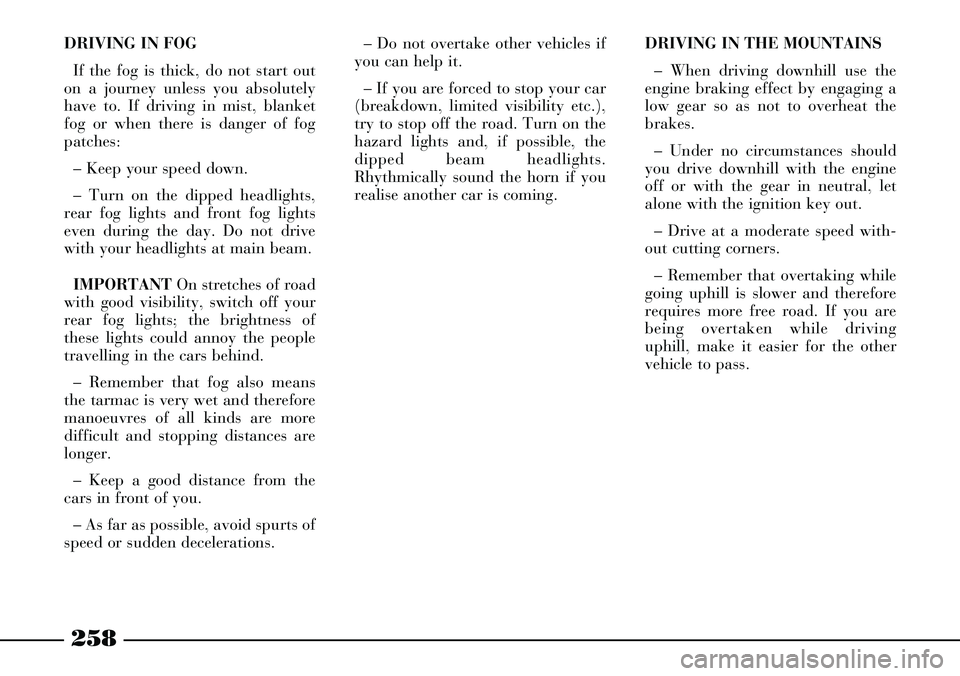
258
DRIVING IN FOG
If the fog is thick, do not start out
on a journey unless you absolutely
have to. If driving in mist, blanket
fog or when there is danger of fog
patches:
– Keep your speed down.
– Turn on the dipped headlights,
rear fog lights and front fog lights
even during the day. Do not drive
with your headlights at main beam.
IMPORTANTOn stretches of road
with good visibility, switch off your
rear fog lights; the brightness of
these lights could annoy the people
travelling in the cars behind.
– Remember that fog also means
the tarmac is very wet and therefore
manoeuvres of all kinds are more
difficult and stopping distances are
longer.
– Keep a good distance from the
cars in front of you.
– As far as possible, avoid spurts of
speed or sudden decelerations. – Do not overtake other vehicles if
you can help it.
– If you are forced to stop your car
(breakdown, limited visibility etc.),
try to stop off the road. Turn on the
hazard lights and, if possible, the
dipped beam headlights.
Rhythmically sound the horn if you
realise another car is coming. DRIVING IN THE MOUNTAINS
– When driving downhill use the
engine braking effect by engaging a
low gear so as not to overheat the
brakes.
– Under no circumstances should
you drive downhill with the engine
off or with the gear in neutral, let
alone with the ignition key out.
– Drive at a moderate speed with-
out cutting corners.
– Remember that overtaking while
going uphill is slower and therefore
requires more free road. If you are
being overtaken while driving
uphill, make it easier for the other
vehicle to pass.